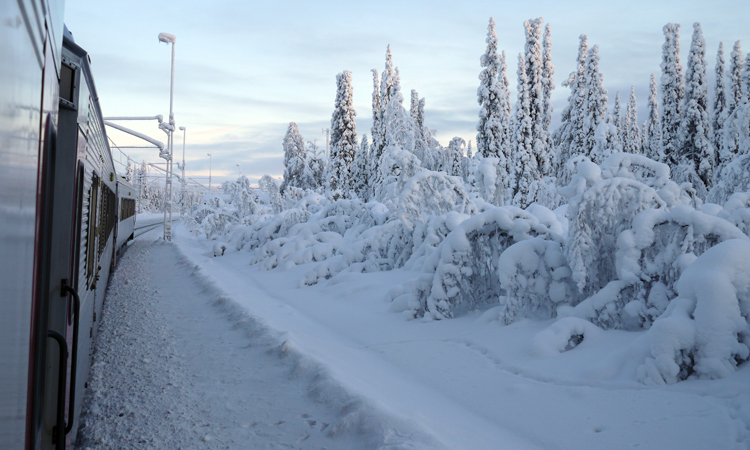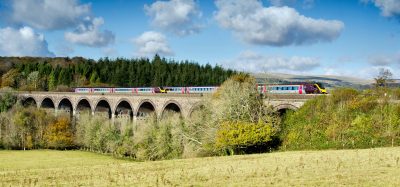Winter preparations for the Swedish railways
Posted: 5 December 2015 | Stefan Jonsson | 1 comment
Trafikverket – the Swedish Transport Administration – is prioritising winter maintenance so that rail transport runs punctually, even during harsh conditions. Trafikverket’s Spokesman for Railway Winter Services, Stefan Jonsson, explains there needs to be a high level of preparedness and knowledge to be able to handle the effects of the weather on the railways throughout the country.


Credit: Göran Fält
Trafikverket is responsible for the long-term planning of the transport system for vehicle, rail, sea and air transport as well as for the construction, operation and maintenance of the national roads and railways.
Sweden is one of the countries that have opened up their railways to competition. We have gone from a monopoly to open competition through re- and de-regulations. Trafikverket has overall responsibility for the rail infrastructure. We own a few snow blowers but in general we have no resources of our own for maintenance works. The authority is purely a contracting organisation and hires external contractors for all works on the tracks.
All rail companies that fulfil the requirements for safety and economic viability may apply for schedules to provide transport on the Swedish railways. At least 30 different rail operators currently provide transport for the Swedish railway network, with 45 having applied for track capacity for 2016. Both regional collective transport authorities and larger industries may apply to Trafikverket with their own schedulees. As the infrastructure manager, Trafikverket then allocates train paths to the different rail operators.
Risk factors
Snow and cold temperatures are the main factors that make rail transport difficult in winter.
In northern Sweden, snow and wintry weather usually appear as early as mid-October. In Stockholm, there may be winter conditions at the beginning of December and in southern Sweden from the start of the New Year. But there are, of course, great variations in the weather from year-to-year.
Trafikverket, contractors and rail operators in Sweden are cooperating effectively to reduce disruptions caused by the winter weather. Disruption plans are in place, but if we get a severe winter with a lot of snow and cold temperatures throughout Sweden, it may still be difficult to cope.
Trafikverket acquires weather forecasts and warnings from the Swedish Meteorological and Hydrological Institute (SMHI) and sub-orders resources based on these. We mobilise resources at an early stage rather than wait for the snow to fall.
In the countryside around the Östersjön Lake, the winter weather can be extreme. If the Östersjön is ice-free and there is a north-northwest wind, the winds can take up a lot of moisture. The effect is similar to that of artificial snow on ski slopes. An extreme example is December 1998, when a snow storm resulted in the loss of all communications in Gävle (170km north of Stockholm). For three days the depth of the snow increased from 1cm to 131cm. Another example of extreme weather was in Kårsta (only 25km north of Stockholm) where a temperature of -38.6° Celsius was recorded on 7 January 1987.
In planning for winter preparedness, Trafikverket focuses on the following five risk factors:
- Class 2 warning from the SMHI, with large amounts of snow (Class 1: low risk; Class 2: moderate risk; Class 3: extreme weather, high level of risk)
- Strong wind
- Extreme cold
- Significant amounts of snow on large expanses of land
- Snow coverage throughout the country.
Management and direction
Detailed snow removal plans play a pivotal role in the winter works. A constant issue is how the resources should be distributed when the bad weather hits Sweden. One option is to move several resources to one place, but that, of course, takes time.
There is a nationwide management structure within the transport management, which means that Trafikverket, contractors and rail operators can, with sustained effort, operate with enhanced cooperation.
The following points are prioritised in order to achieve optimal winter maintenance:
- Continuous feedback of experiences
- Consolidation meetings with operators and contractors
- Project Leader in state of constant preparedness
- Agreements with contractors for rapid error rectification
- Snow removal plans for goods railway depots
- Increased monitoring of supplies
- Daily production meetings for railways
Reduction of rail timetables
To reduce the risk of trains standing on the tracks, for example during heavy snowfall, Trafikverket may decide to reduce the level of transport which means some trains are discontinued to allow others to run. The reason we reduce the transport is for us to be able to carry out additional maintenance measures in the event of, for example, storms, high water levels and heavy snowfall. This can involve removing fallen trees, clearing snow, repairing overhead contact lines that have been brought down in a storm, etc.
The objective is for trains to continue to run, fewer in number but where possible with more carriages.
So-called reduction plans are developed in close dialogue with the rail operators. Drawing-up plans in advance to determine which trains may be discontinued in different situations makes it easier for both Trafikverket and the rail operators to plan the transport and provide travellers with information and alternative routes.
Works
Great care is taken to ensure that the switches function properly, even in severe winter weather. Special snow removal zones have been arranged to enable the switches to function.
During heavy snowfall there will be a different approach to using the switches. Many cross switches, which normally enable the tracks to be switched outside on the tracks, will be locked in the straight position. Fewer than 100 prioritised switches have been selected and optimised for winter. These have been provided with brushes, ploughs and wedges. Brace pits and links have been coated with plywood and fitted with heating coils.
Stockholm Central Station, which is important for a large proportion of the transport, will have a relatively large number of tracks in operation while there will be serious reductions elsewhere.
With a Class 2 warning, work teams will be working double-shifts with the aim of responding quickly to clear prioritised switches of snow. There will be occasional standstills, in the worst cases for 20 minutes, while the snow is cleared followed alternately by 20 minutes to allow the traffic to run.
A great number of switches are supplied with heating coils. There is now new technology that can sense what the weather is like locally and supply heat to the switches depending on the weather. In addition to monitoring the temperature in a switch heating chamber, the same system also enables computers to identify and localise faults in individual switches. The most important actions to take ahead of the winter season with regard to the switches are:
- Monitoring the switch heat
- Protection from snow in the switches
- Camera surveillance of critical switches
- Keeping the tarmac areas clear and cleaning underneath the switches.
Resources
Trafikverket can employ around 1,500 people and 300 vehicles for winter maintenance. In addition, we can demand that contractors redistribute their resources, if this is required. The following large special vehicles for snow removal are available:
- 1 SR 300 medium-sized snow-melting machine/switch cleaning machine (Stockholm)
- 2 SR100 smaller snow melters, designed for the removal of ice from vehicles (Gothenburg and Stockholm)
- 2 SR 200 snow ploughs (Stockholm and Hallsberg)
- 1 Snow Removal 700
- 2 SR 700 snow removal machines (Stockholm and Hallsberg)
- New this year: a rail-mounted snow blower, which has been acquired for the Malmbanan (Kiruna-Narvik). It arrives in Kiruna at the end of November 2015 and will be tested during the winter 2015/2016.
At a large depot, a snow depth of 69cm (which is not uncommon) may mean there is up to a million cubic metres of snow on site. It requires huge resources and the right working method to be able to keep the surface area free of snow so that rail traffic is not hindered. Dealing with the snow only once saves a huge amount of time. With this in mind, an enormous snow melter has been devised.
The Swedish company Railcare developed a combined snow removal and snow melting machine for railway depots as early as in 2011. Together with Trafikverket, the company has now launched two new snow removal machines. These are developed versions of the rail-mounted snow melting machine Snow Removal 700, combined with an entirely new snow plough, SR 200, which in fact has two ploughs, one at either end of the carriage.
The SR 700 takes just 20 minutes to remove snow from 700m of track, over 5m-wide, i.e. including the walking surfaces required by the switching personnel. The snow is then melted down to approximately 10% of the original volume. After two or three rounds, the water is emptied out.
The two side brushes extend 2.5m in both directions from the centre of the track. Their purpose is to sweep snow in towards the centre. A main brush sweeps up the snow that is sucked into the machine’s first carriage, where the snow collects in a melting vat with water that is heated by a diesel-driven boiler with a capacity of 12 megawatts. The snow then melts to water which is pumped over to a large tank in the next carriage.
Impurities in the snow are collected in a trap which can be emptied later and taken to a waste disposal facility. The melted water is emptied into drains or gullies on the site of the depot.
The SR 200 enables ploughing in both directions without turning the carriage around. It is driven by a locomotive, which is available. The SR 200 has a very special plough blade, which is divided into four sections (a total of 8.3m-wide). These can be adjusted and raised/lowered to different levels for very precise and effective snow removal, and can even be formed into a hopper that projects the snow ahead of it, which in turn means that the snow can be loaded and disposed of safely without having to close off large parts of the track area. The SR 200 is designed for stations and smaller depots. Together, these machines help to keep the snow away from the tracks.
The TB locomotive is a heavy-duty diesel-electric locomotive with a robust engine that is able to plough through large, heavy snow masses and ice. It has very wide plough blades capable of clearing three tracks at the same time, which makes it extremely useful and effective, for example, at a railway depot.
Like the TB, the TC locomotive is a locomotive for ploughing snow, but it is not as powerful. On the other hand, it is easier to handle and is more flexible in that the plough blade can be replaced and used for other purposes. It is used mainly outside on the tracks.
A snow sucker functions like a snow blower: the snow is sucked in and projected out at the side of the track. By means of wheel loaders, snow can be lifted onto snow carriages for removal. This can be done, for example, at a depot where there is not as much space for large amounts of snow at the sides as there is out on the tracks.
A common instrument for cleaning switches is a snow broom, which may resemble a work vehicle, such as a locomotive or rail excavator, with a large broom mounted at the front. Switches may also need to be cleaned manually with a hand tool so that sensitive materials in the track or switch are not damaged.
Overall strategy
By reducing the number of trains on the tracks in the event of heavy snowfall, we are freeing-up space for the people and machines that remove snow. We make sure that specific sections of the track are completely cleared of snow, which means that trains can reach their destinations. It’s better to have a small number of trains running than a lot of trains standing still. This is a working method we have devised with the rail operators in advance. The focus is on cooperation in order to do the best we can for travellers in extreme winter conditions. For example, we’ll be able to inform travellers more quickly since reduced train timetables are already in place. The public will be advised of the situation in good time, and will be able to make their own travel plan decisions.
Biography


OUT NOW: The Definitive Guide to Rail’s Digital Future
The rail industry is undergoing a digital revolution, and you need to be ready. We have released our latest market report, “Track Insight: Digitalisation.”
This is not just another report; it’s your comprehensive guide to understanding and leveraging the profound technological shifts reshaping our industry. We move beyond the buzzwords to show you the tangible realities of AI, IoT, and advanced data analytics in rail.
Discover how to:
- Optimise operations and maintenance with real-time insights.
- Enhance passenger services through seamless, high-speed connectivity.
- Leverage technologies like LEO satellites to improve safety and efficiency.
Featuring expert analysis from leaders at Nomad Digital, Lucchini RS, Bentley Systems and more, this is a must-read for any rail professional.
Issue
Related topics
Adverse Weather, Operational Performance, Regulation & Legislation, Safety








How do you cope with ice and snow on overhead electrical wires? I know ice can weigh heavily and bring them down.